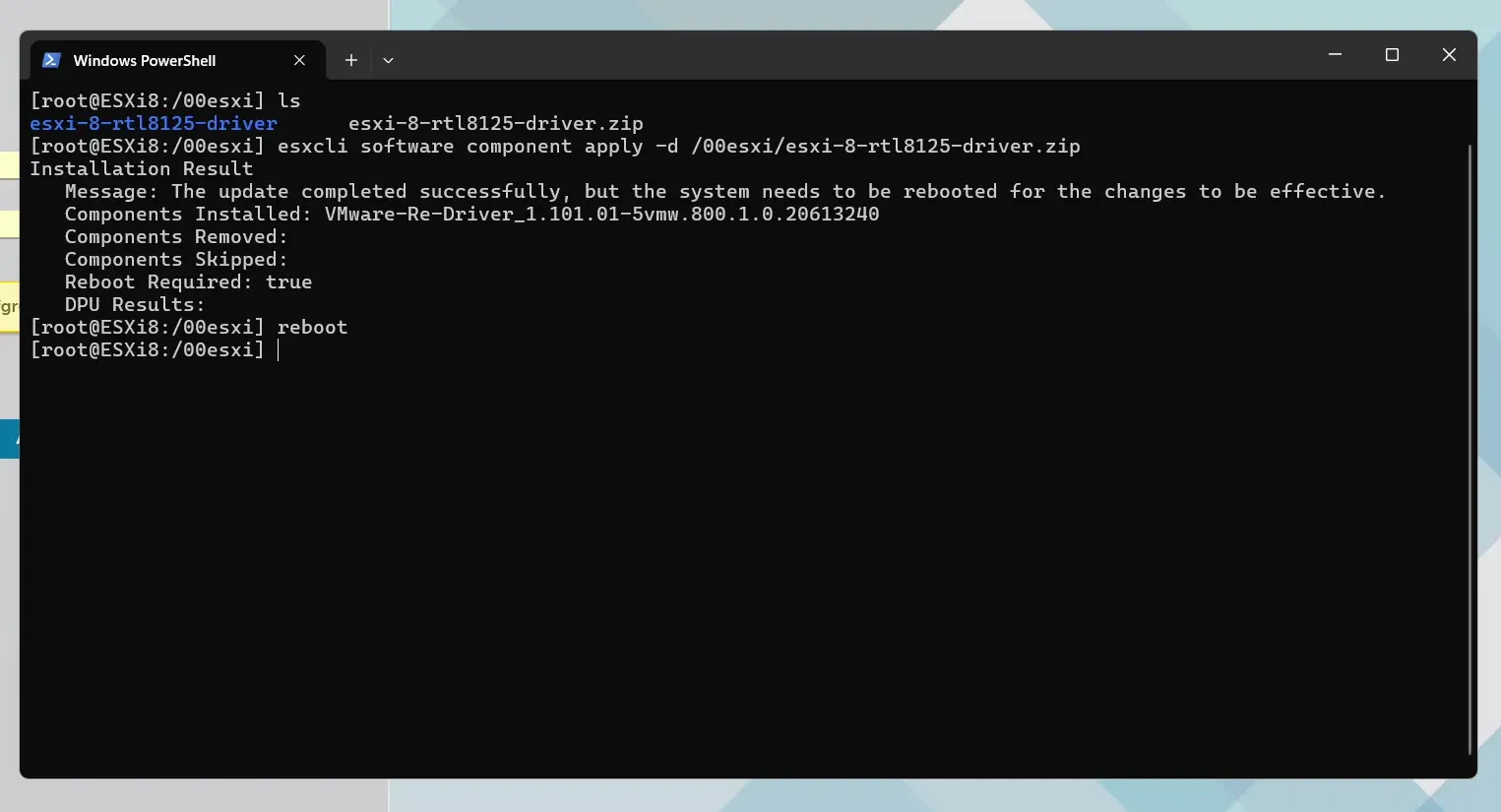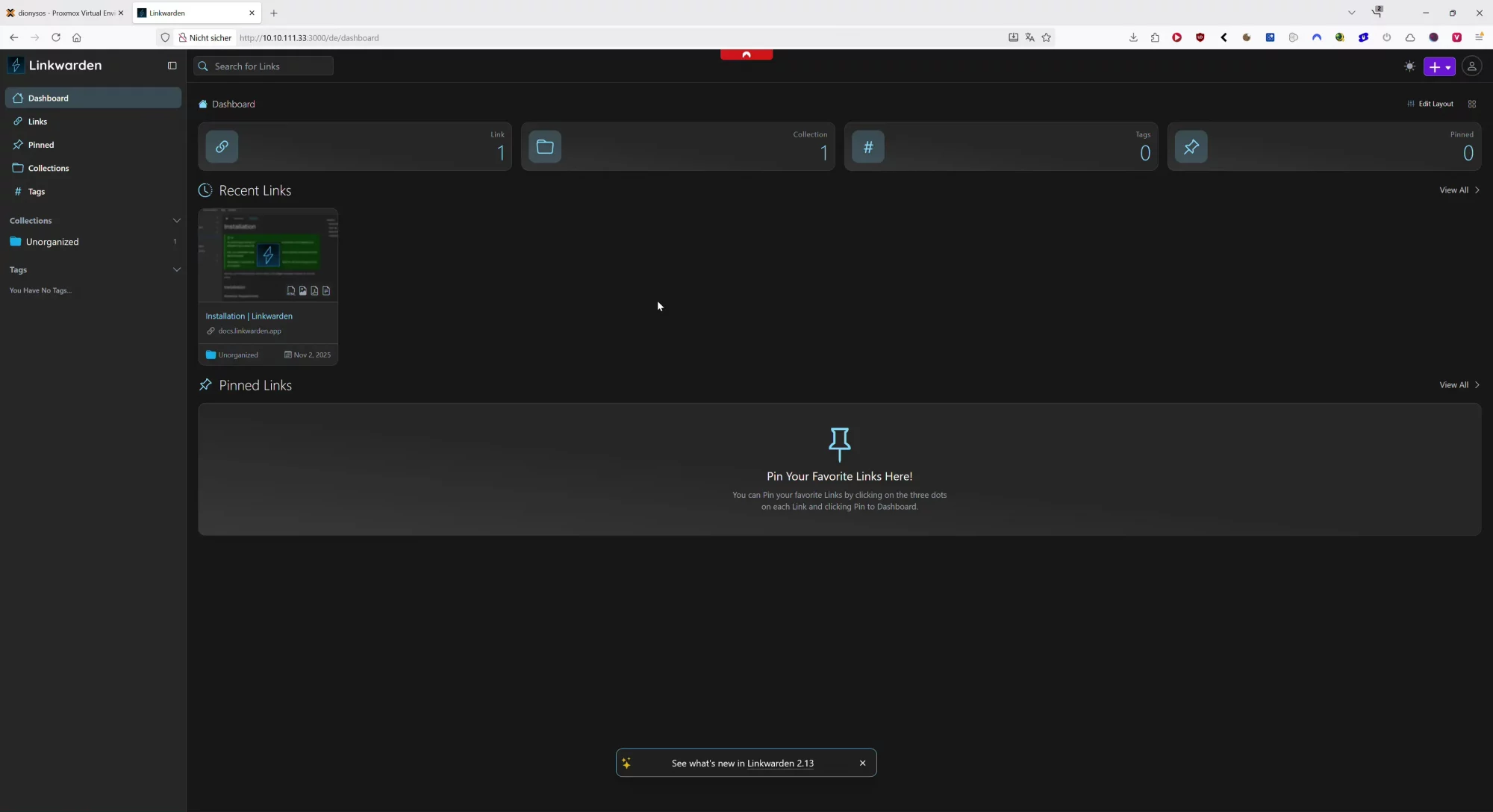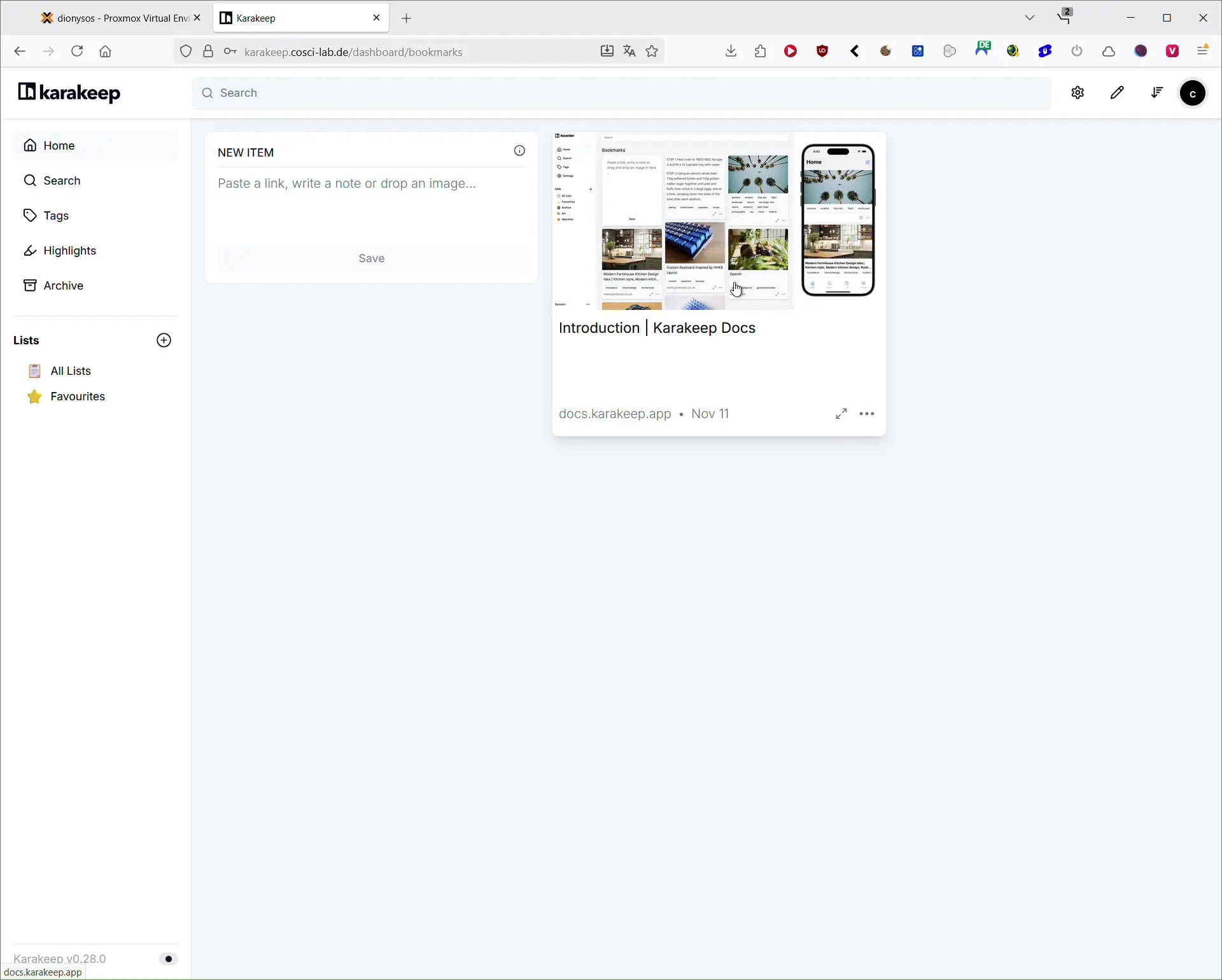- Install Realtek Network Driver on ESXi 8.0.3 – Why you need it
- What is an ESXi server
- Example hardware – Minisforum MS-A2 with ESXi 8.0.3
- Why ESXi 8.0.3 does not ship a Realtek network driver
- Realtek Network Driver for ESXi from Broadcom Flings
- Register and download from the Broadcom Support Portal
- Preparation before installing the Realtek ESXi driver
- Install Realtek network driver on ESXi 8.0.3
- 1 – Copy the driver to the ESXi host
- 2 – Connect to the ESXi host via SSH
- 3 – Check current network adapters
- 4 – Install the Realtek network driver
- 5 – Reboot the ESXi host
- Update or remove the Realtek ESXi driver
- Jumbo Frames and advanced settings
- Typical issues and troubleshooting
- Homelab vs production – when Realtek makes sense
- FAQ – Realtek network driver for ESXi 8.0.3
- Glossary – Key terms around ESXi and Realtek drivers
- Explanation of all commands used in this guide
Install Realtek Network Driver on ESXi 8.0.3 – Why you need it
If you use a cheap mini PC or desktop as an ESXi server, you will quickly run into Realtek network adapters. As soon as you install ESXi 8.0.3 the disappointment follows – the hypervisor does not find a compatible NIC and either stops the installation or shows no usable network port afterwards.
That is exactly what happened with my Minisforum MS-A2 running VMware ESXi 8.0.3 build 24677879. The system has several Intel ports and one Realtek RTL8125 2.5 GbE adapter. The Intel ports worked right away, but ESXi completely ignored the Realtek interface.
Today there is a solution for this problem – the Realtek Network Driver for ESXi from the Broadcom Flings section. In this guide I show you how to install the Realtek network driver on an ESXi 8.0.3 host, which Realtek chipsets are supported, which limitations you should be aware of and how to troubleshoot problems after the installation.
What is an ESXi server
ESXi is VMware’s bare metal hypervisor. It is installed directly on the hardware and brings its own minimal operating system. On top of that you run your virtual machines, containers or virtual appliances.
Typical use cases:
- Homelab and test environments
- Small virtualization servers in offices
- Foundation for vSphere clusters with vCenter, vMotion, HA and more
Important: ESXi talks directly to the hardware. If there is no driver for a network adapter, there is no fallback through a host operating system like with VMware Workstation. Without a supported NIC you cannot manage the server over the network.
Example hardware – Minisforum MS-A2 with ESXi 8.0.3
On my ESXi 8.0.3 host the following configuration is running:
- Server – Minisforum MS-A2
- ESXi version – VMware ESXi 8.0.3 build 24677879
Network ports:
- 2x Intel X710 (10 GbE SFP+)
- 1x Intel i226-V (1 GbE)
- 1x Realtek RTL8125 (2.5 GbE)
Right after the installation the NIC list looked like this:
| Name | PCI Device | Driver | Speed | Description |
|---|---|---|---|---|
| vmnic0 | 0000:04:00.0 | cndi_igc | 1000 | Intel Corporation Ethernet Controller I226-V |
| vmnic1 | 0000:05:00.0 | i40en | 1000 | Intel Ethernet Controller X710 for 10GbE SFP+ |
| vmnic2 | 0000:05:00.1 | i40en | 1000 | Intel Ethernet Controller X710 for 10GbE SFP+ |
| vmnic3 | 0000:03:00.0 | if_re | – | Realtek RTL8125 2.5GbE Controller – not detected |
Why ESXi 8.0.3 does not ship a Realtek network driver
VMware officially supports mainly server grade NICs from Intel, Broadcom, Mellanox and a few others. Realtek chipsets are not the preferred choice in the VMware Hardware Compatibility Guide, because they are typically used in consumer hardware.
Some background why ESXi 8.0.3 does not include a Realtek network driver:
- Realtek does not ship an official ESXi driver.
- Legacy vmklinux drivers have been removed since ESXi 7, only native drivers remain.
- Desktop hardware with Realtek NICs is mostly a homelab topic rather than a production use case.
The good news – VMware and Broadcom provide a Realtek Network Driver for ESXi in the Flings area. It is not fully supported in the same way as enterprise drivers, but it works very well for homelab setups.
Realtek Network Driver for ESXi from Broadcom Flings
The Realtek Network Driver for ESXi is a so called Fling. That means:
- It is an officially published but experimental project from VMware or Broadcom.
- It is perfect for homelabs and test environments.
- For critical production workloads you should still use officially supported NICs.
The driver currently supports the following Realtek chipsets:
| Chipset | Speed |
|---|---|
| RTL8111 | 1 GbE |
| RTL8125 | 2.5 GbE |
| RTL8126 | 5 GbE |
| RTL8127 | 10 GbE |
Good to know:
- The Realtek network driver for ESXi mainly provides basic network connectivity.
- Hardware offloads like TSO, LRO or Wake on LAN are not supported at the moment.
- For homelab, backup networks or management networks this is absolutely fine in practice.
Register and download from the Broadcom Support Portal
The driver is available in the Broadcom Support Portal under the Flings section. You need a free Broadcom account to download it.
Here you can find the Realtek driver (link) (link with ads to support our blog)
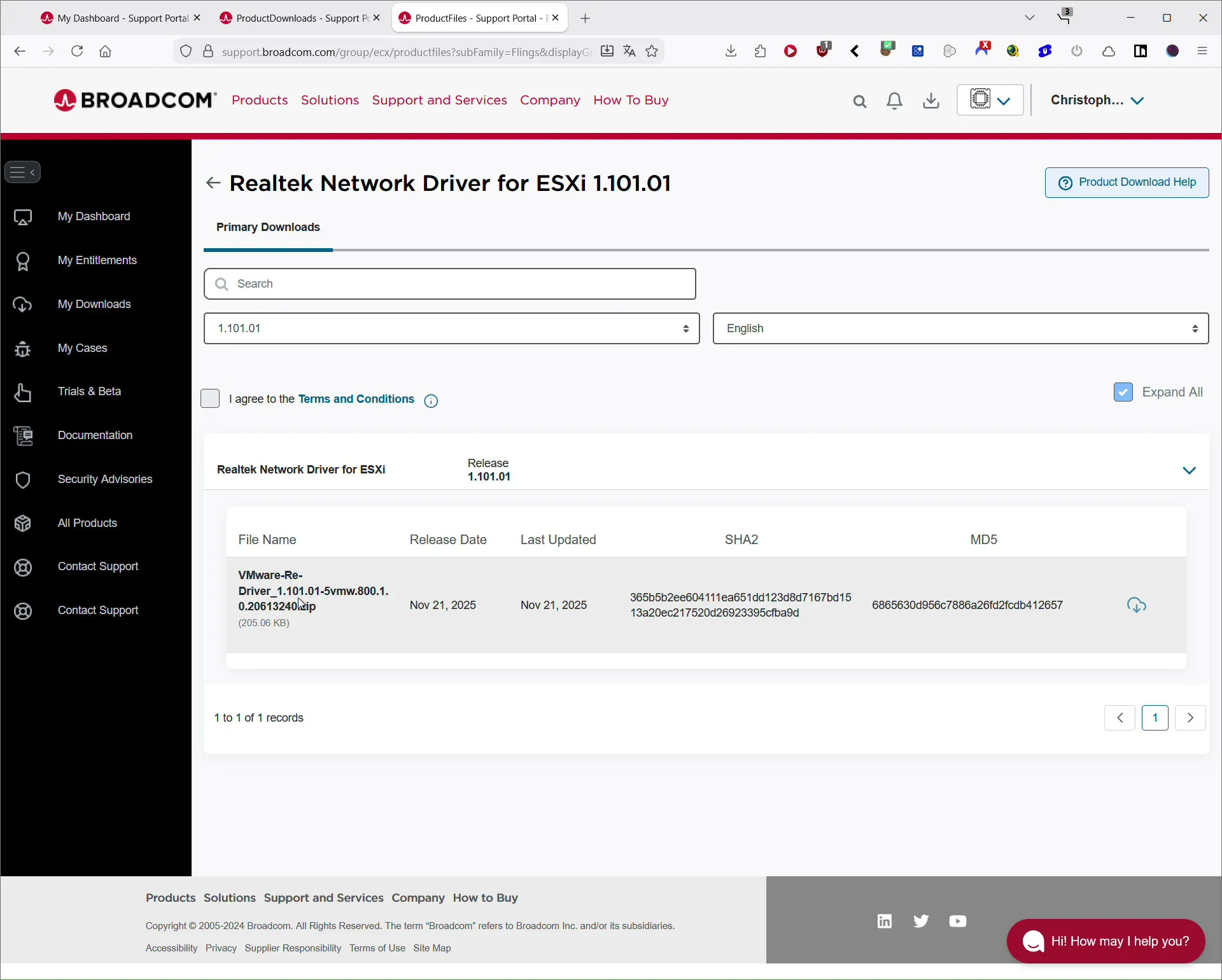
Steps:
- Register a free account on the Broadcom Support Portal.
- When you log in the form asks for a username – simply enter the email address you used during registration. There is no separate username, which can be confusing.
- After login search for “Realtek Network Driver for ESXi”.
- Download the current version of the offline bundle ZIP, for example
VMware-Re-Driver_1.101.01-5vmw.800.1.0.20613240.zip.
Tip: Read the short release notes and check whether your ESXi build is mentioned. The Realtek network driver supports ESXi 8.0 Update 3 and newer vSphere releases.
Legal side note: Do not reupload the ZIP file to random file hosts. Instead link to the official Broadcom download page so every user accepts the license terms themselves.
Preparation before installing the Realtek ESXi driver
Before you install the Realtek network driver on ESXi 8.0.3 you should prepare a few things:
- Make sure the Realtek NIC is enabled in BIOS or UEFI.
- Ensure that you have at least one working NIC for management access.
- Create a backup or at least note down your current ESXi version and build number.
- Enable SSH on the ESXi host in the web interface under “Manage – Services”.
After that create a directory on your ESXi host for driver files. I like to use /00esxi because it is easy to remember and appears at the top of directory listings.
Install Realtek network driver on ESXi 8.0.3
1 – Copy the driver to the ESXi host

On my Windows machine I used WinSCP to copy the ZIP file directly to /00esxi on the ESXi host. Alternatively you can:
- use the datastore browser in the web interface
- or copy the file via
scpfrom a Linux system
In the end you should see something like this:
ls /00esxi
VMware-Re-Driver_1.101.01-5vmw.800.1.0.20613240.zip
There is no need to unpack the ZIP file.
2 – Connect to the ESXi host via SSH
Connect to the host via SSH, for example with PuTTY or Windows PowerShell:
ssh root@your-esxi-host
3 – Check current network adapters
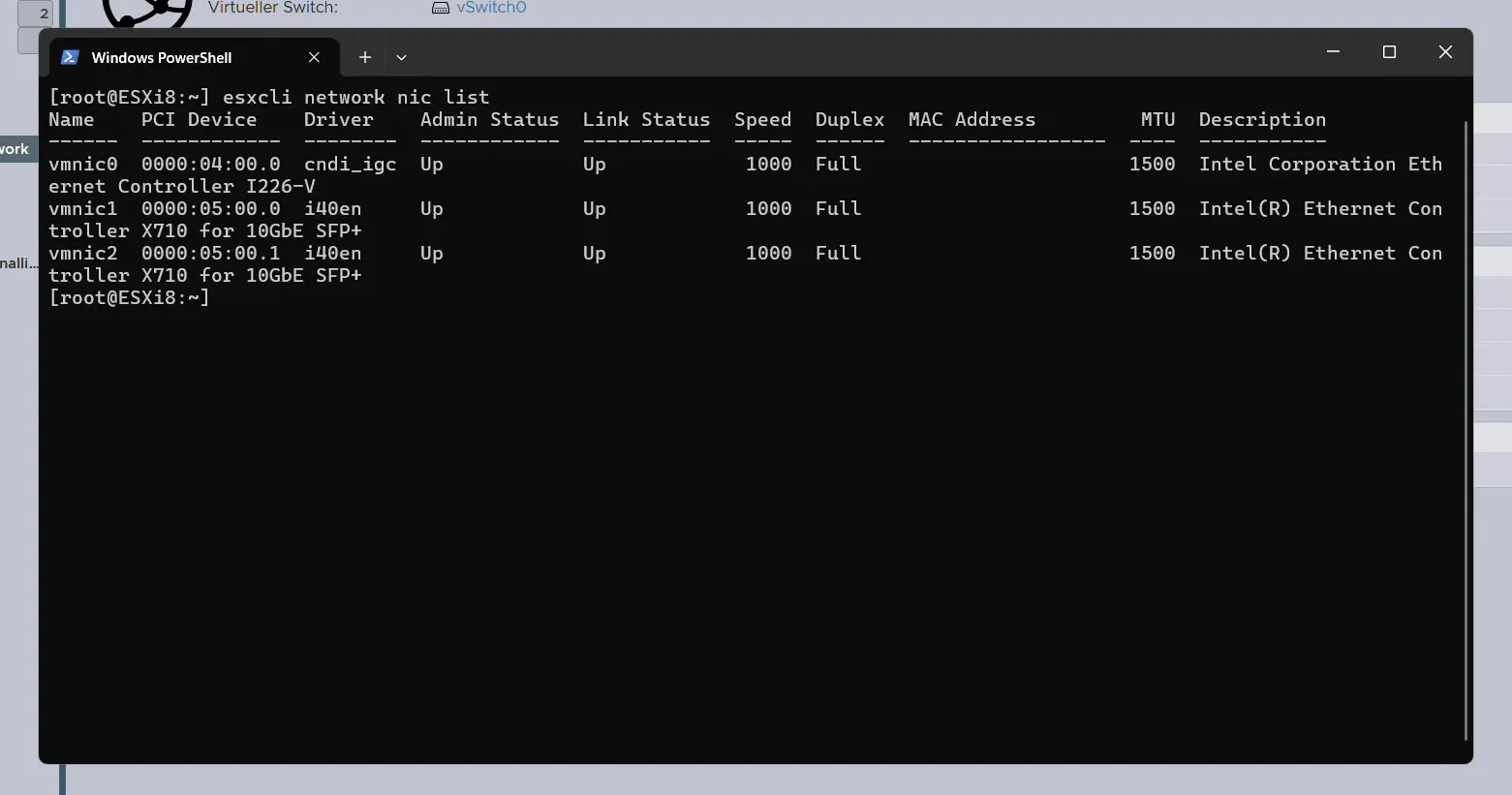
Before the installation you can check which NICs ESXi currently sees:
esxcli network nic list
At this point usually only the Intel cards are listed.
4 – Install the Realtek network driver
Now install the Realtek network driver for ESXi 8.0.3 with the following command. The full path to the ZIP file is important:
esxcli software component apply -d /00esxi/VMware-Re-Driver_1.101.01-5vmw.800.1.0.20613240.zip
Typical output contains lines like:
Update completed successfullyComponents Installed: VMware-Re-Driver_1.101.01-5vmw.800.1.0.20613240Reboot Required: true
5 – Reboot the ESXi host
To load the Realtek network driver you have to reboot the host:
reboot
After the reboot log in again and check the network interfaces:
esxcli network nic list
Now you should see an additional adapter with driver if_re, for example:
vmnic3with description “Realtek Semiconductor Co., Ltd. RTL8125 2.5GbE Controller”
In the ESXi web UI under “Networking – Physical NICs” the card should now show up and can be assigned to a vSwitch.
Update or remove the Realtek ESXi driver
If a newer version of the Realtek network driver for ESXi becomes available, you can upgrade with the same command:
esxcli software component apply -d /00esxi/VMware-Re-Driver_1.101.xx-5vmw.800.1.0.20613240.zip
To completely remove the Realtek network driver use:
esxcli software component remove -n VMware-Re-Driver
Again, a reboot is required afterwards.
Jumbo Frames and advanced settings
Jumbo frames cannot be configured on the vSwitch for this driver. Instead you configure the MTU as a module parameter for the if_re driver. Example for MTU 9000:
esxcli system module parameters set -m if_re -p mtu=9000
reboot
Make sure that all switches and devices on the path use the same MTU value, otherwise you will run into strange network issues.
Typical issues and troubleshooting
A few common pitfalls that can save you time:
- The Realtek NIC is disabled in BIOS and therefore does not show up as PCI device or NIC.
- You installed a driver version that does not match your ESXi build. In that case install the correct version for your ESXi release.
- After an ESXi upgrade the Realtek card disappears again. Then you need to reinstall the Realtek network driver for the new version or build a custom ISO with the driver included.
With esxcli software component list you can verify whether the VMware-Re-Driver component is installed. With dmesg or the ESXi logs you can see if there were errors when loading the if_re module.
Homelab vs production – when Realtek makes sense
Realtek network drivers on ESXi 8.0.3 are a great way to use cheap mini PCs or desktops in a homelab. Ideal use cases:
- Test clusters at home
- Backup networks, lab VLANs, management access
- Virtual routers, firewall VMs or lab storage
For production environments I still recommend officially supported Intel or Broadcom NICs. Benefits:
- full VMware support
- stable drivers with advanced offload features
- better documentation and firmware management
FAQ – Realtek network driver for ESXi 8.0.3
Does ESXi 8.0.3 officially support the Realtek RTL8125 card
No. Realtek NICs are not part of the official VMware Hardware Compatibility List. The Realtek Network Driver for ESXi from Broadcom Flings works well but is mainly targeted at homelab users.
Is the Realtek Network Driver for ESXi safe to use
Yes. The driver is published by VMware and Broadcom in the Flings section. It is experimental and not covered by standard enterprise support, but it is not some random third party hack.
Do I need to extract the ZIP file before installing
No. The ZIP file is an offline bundle and is used directly with esxcli software component apply.
Why does my Realtek NIC not show up in the ESXi web interface
Possible reasons:
- NIC disabled in BIOS
- driver installation failed
- host not rebooted after installation
- incompatible driver version for your ESXi build
- rarely – PCI slot handled differently by the platform
Does the Realtek ESXi driver support offloading or Wake on LAN
No. The Realtek network driver for ESXi only offers basic network connectivity. Offload features like TSO, LRO, WOL and energy saving features are not supported.
Can I enable jumbo frames on the Realtek card
Yes, but not on the vSwitch directly. You have to set the MTU through the module parameter:
esxcli system module parameters set -m if_re -p mtu=9000
reboot
Can an ESXi upgrade remove the driver again
Yes. A major ESXi upgrade can overwrite the driver. Then you either reinstall the Realtek network driver or use a custom ESXi ISO that already contains it.
How do I uninstall the Realtek ESXi driver
esxcli software component remove -n VMware-Re-Driver
reboot
Can I upload the driver ZIP file to my own download server
You should not. The file is protected by the Broadcom license. Link to the official Broadcom download page instead.
Glossary – Key terms around ESXi and Realtek drivers
| Term | Explanation |
|---|---|
| ESXi | VMware bare metal hypervisor that runs directly on the hardware and hosts virtual machines. |
| vmnic | Internal ESXi name for a physical network adapter, for example vmnic0, vmnic1. |
| Fling | Experimental project published by VMware or Broadcom, officially available but without full enterprise support. |
| RTL8125 | 2.5 GbE Realtek network chipset widely used in mini PCs and consumer mainboards. |
| NIC | Network Interface Card – a physical network adapter. |
| Driver | Software that allows ESXi to talk to a hardware component such as a NIC. |
| SSH | Secure Shell – secure remote console connection to a server. |
| Offline bundle | ZIP file that contains drivers or components and can be installed with esxcli. |
| vSwitch | Virtual switch inside ESXi that connects VMs and physical NICs. |
| TSO / LRO | Network offload features that reduce CPU load. Not supported by the Realtek ESXi driver. |
| Jumbo frames | Network frames with an MTU larger than 1500 bytes. For the Realtek driver the MTU is set via module parameters. |
Explanation of all commands used in this guide
esxcli network nic list
Lists all physical NICs detected by the ESXi host.
The output shows:
- adapter name (for example vmnic0)
- PCI address
- used driver
- link status and speed
- MAC address
Useful to check whether the Realtek card is detected and if the driver is loaded.
esxcli software component apply -d /path/to/file.zip
Installs or updates a software component from an offline bundle.
Important parts:
software component apply– install or update action-d– defines the path to the ZIP file
ESXi then:
- reads the bundle
- extracts the components
- installs or upgrades them
After a successful run you usually see a line that a reboot is required.
reboot
Reboots the ESXi host.
Needed so that:
- new drivers are loaded
- kernel modules are initialized
- network adapters are re detected
esxcli software component remove -n VMware-Re-Driver
Uninstalls the Realtek network driver from the ESXi host.
Parameters:
remove– uninstall operation-n VMware-Re-Driver– name of the component to remove
After removing the component you should reboot the host.
esxcli system module parameters set -m if_re -p mtu=9000
Sets module parameters for a kernel module.
-m if_re– name of the Realtek driver module-p mtu=9000– sets MTU size of the adapter to 9000 bytes
Effective after a reboot. All devices in the path must use the same MTU.
esxcli software component list
Shows all installed software components on the ESXi host.
You can use this to check:
- whether the
VMware-Re-Driveris installed - which version of the Realtek driver is active
